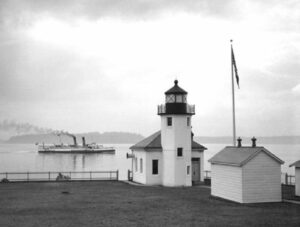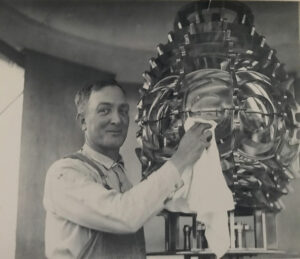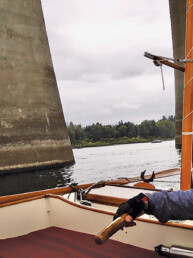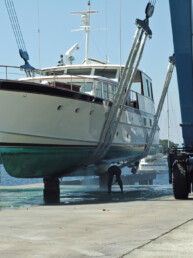Explore the history of the iconic lighthouse that has been guiding mariners through Puget Sound for more than 100 years.
The following article originally appeared in the May 2022 issue of 48° North.
Seattle is a city best viewed from the water. The downtown skyline, dominated by the Space Needle on one side and the snowy majesty of Mt. Rainier on the other, never fails to impress. Mariners look for another iconic landmark, the Alki Point Lighthouse, which has greeted vessels at Elliott Bay’s southern entrance for more than a century.
Over the years I have explored this beacon from my sailboat, kayak, and dinghy. Day and night, it is a welcome sight on the water — one that signals “home” to me. Unlike the coastal lights that sit on isolated bluffs, towering above crashing surf (such as North Head; see 48° North’s November 2021 issue) the Alki Point beacon seems accessible and visibly connected to nearby communities.
Alki Point, which extends into Puget Sound from West Seattle, marks a convergence of Indigenous cultures, settler colonial history, maritime commerce, and residential development. This is the traditional land of the Duwamish — Seattle’s first people — and it is near the place where the Denny party landed in 1851, launching an era of colonization that expanded along the shores of Elliott Bay throughout the 19th century.
Puget Sound served as a water highway for the new city, which became a major supply point for the Yukon and Alaska during the Klondike Gold Rush (1897-1898). Seattle’s sheltered, deep-water harbor and its central location in the Salish Sea made it ideal for marine transportation. During the 1910s, the steamers of the mosquito fleet made regular calls, connecting the city’s passengers and freight with other local ports.
Light Station Features
Improved navigational aids were crucial during this period of growth, replacing earlier lights that appear crude by today’s standards. At Alki Point during the late 19th century, for example, a lantern suspended from a post — holding enough fuel for eight days — guided vessels through the southern approach to Elliott Bay. The new century called for something more substantial, resulting in the construction of a 37-foot octagonal concrete and masonry tower with an attached fog signal structure.

The Alki Point Lighthouse became operational in 1913. Painted white, the tower included a fourth-order Fresnel lens, typically used to mark shoals, reefs, and harbor entrances. This lens featured multiple bull’s-eye panels and measured more than two feet in height and 20 inches in diameter, weighing approximately 500 pounds. A clockwork mechanism, powered by a suspended weight, rotated the lens every ten seconds, producing a group of five white flashes followed by a five-second eclipse. To keep the lens revolving, the weight was wound every five hours. While the lamp used kerosene in the early years, by 1918 an electric light provided illumination. Visible for 12 miles, the beacon at Alki Point became a familiar sight to vessels in the busy shipping lanes west of the city.
The light station also featured a three-trumpet fog signal, invented and manufactured by Celadon L. Daboll of New London, Connecticut. The sound came from two engines that produced compressed air, passing across a vibrating reed. Trumpets projected the blast in three directions. In 1947, an electric single stage Worthington Air Compressor and twin Leslie-Typhon horns replaced the original equipment, producing two blasts every 30 seconds. Locals were aware of this signal, on shore as well as from the water. “As a navigation aid, the Alki horn does pretty well on dry land,” reported a tongue-in-cheek article in the Seattle Daily Times. “Gauging their positions by the sound whenever the fog clamps down, veteran residents of the area can drive their cars smack into their garages with their eyes closed.” (Dec. 12, 1943).
The Keepers and the Alki Community

Residing in two large houses behind the tower, the light station keepers maintained close ties with the local community. Henry Mahler, the first head keeper, served for 17 years before retiring in 1930. His daughter Margaret, who was born in a lighthouse at a previous post, grew up at the Alki Point station and got married there on May 2, 1930. According to the Seattle Daily Times, her dream was to become a bride “while the blinker at Alki sends out its flashes across Puget Sound, and the big clock in the tower ticks off the hours.” When asked where she and her new husband would reside, Margaret replied, “It won’t be far from the lighthouse and the foghorn … I love them both.” (May 2, 1930).
The Alki Point keepers were creative, scholarly employees who engaged in pursuits outside the daily routine of lighthouse work. William Auld, the second head keeper, was an artist. Described by the Seattle Daily Times as a “fragile appearing little man with a ruddy face and white moustache,” Auld was an amateur painter who had “lived with the sea all his life.” (Feb. 17, 1935). His watercolors — featuring lighthouses and seascapes — hung on the wall of his residence at the Alki Point station. Charles Eliot assumed the role of head keeper when Auld retired in 1935. A “modest, mild-mannered” man of letters, Elliot devoted his free time to researching Walt Whitman, “America’s greatest poet.” It was a lifelong hobby for Eliot. “Watching the light on long, foggy nights leaves me plenty of time to sit in my library,” he explained (Seattle Daily Times, Sept. 24, 1939).
By the mid-20th century, the Alki Point Lighthouse had become a cherished landmark and a source of pride for Seattle residents. In a column titled “Strolling Around the Town,” the Seattle Daily Times reported a complaint from reader Lillian L. Waldron, who had encountered a postcard from Florida claiming that the southern state was the only one with a lighthouse located in a U.S. city. Calling out this “civic naughtiness,” Waldron checked the status of the Alki Point Lighthouse and learned that it indeed was located within Seattle city limits. “Shall we allow Miami to get away with this?” she asked. “Not with such earnestness as yours around, Mrs. Waldron,” the Seattle Daily Times answered (March 8, 1941).
The Alki Point Lighthouse Today
Although the U.S. Coast Guard took over the Lighthouse Service in 1939, civilian keepers remained at Alki Point until 1970. Eight years earlier, the fourth-order Fresnel lens was replaced with an airway beacon, which flashed every five seconds, shining six times brighter. The original Fresnel lens is now on display at the Admiralty Head Light (see 48° North’s January 2022 issue). In 1984, the Alki Point Lighthouse became fully automated.
In addition to adding its own iconic element to the Seattle waterfront, the light at Alki Point retains its utility for the parade of commercial and recreational traffic transiting Puget Sound. And, if you’re lucky enough to enjoy a moonlight cruise around Elliott Bay this summer, you’ll surely find reassurance in its steady presence.
Lisa Mighetto is a historian and sailor living in Seattle. She is grateful to the Coast Guard Museum Northwest for providing images and information for this article.






